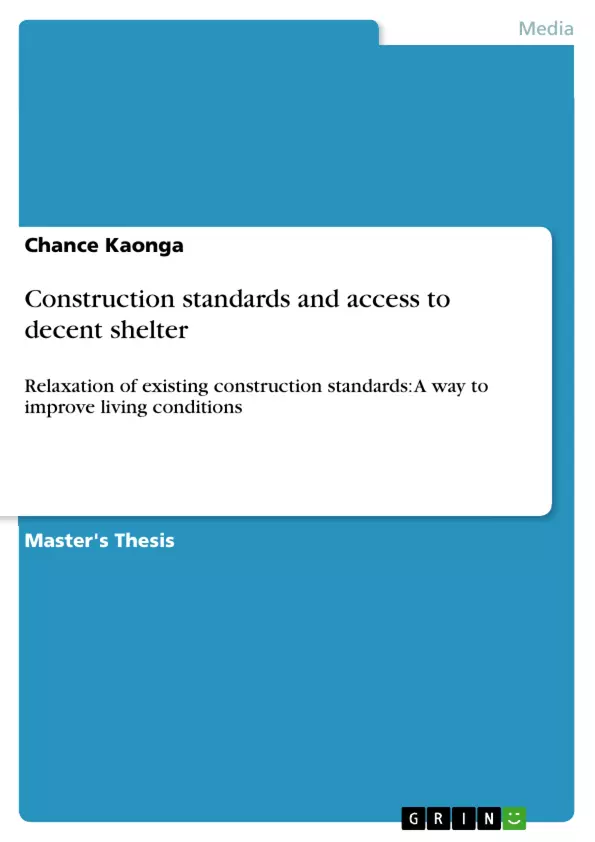This research examines the standards of construction and regulations in Zambia, in light of their effect on the attainment of the acclaimed international rights to adequate shelter for all and development of sustainable human settlements in an urbanising world (UNCHS, 2003).
As argued by Rafael Tuts (1996), that the prohibitively high building and planning standards are often considered as one of the main obstacles to the provision of low-cost housing in developing countries. He further stated that the more and more agencies and stakeholders advocate the relaxation of these standards; the major motivation is the anticipated initial cost reduction .
The statutes governing the development of infrastructure have a genesis from the British system and fundamentals; Zambia was a British colony until 1964. The principal law governing the development control is Chapter 283 of the Laws of Zambia; The Town and Country Planning Act.
As the population of the country grows, the number and size of squatter settlements correspondingly increase. Most of the houses in the squatter settlements are built using construction materials and methods that are not recognised by the statutes. These settlements lack basic infrastructure services such as generous access roads, piped water, sanitation and electricity. The plot lay-outs are usually irregular and of unsecure tenure.
The focus will be on examining the low and medium cost housing schemes implemented thus far and access to such housing over the years. The intervention of some civil society organisations to help provide affordable and decent shelter to the poor and disadvantaged people shall also be delved into. The methods of house production shall be evaluated to determine their performance and appropriateness and adequacy.
Focus shall also be on the construction methodologies and materials used in squatter settlements that have been in existence for over 30 years. The performance of such houses shall be evaluated to determine their suitability and affordability.
An attempt to evaluate the use of local materials in vernacular /traditional setting shall be done with a view of determining their performance and durability.
The study closes by looking at the land administration of the country and access to the basic infrastructure and social service as they impact on the quest for adequate shelter for all.
Inhaltsverzeichnis (Table of Contents)
- ABSTRACT
- CHAPTER ONE
- 1.0 INTRODUCTION
- 1.1.1 Vancouver Declaration:
- 1.1.2 Istanbul Declaration on Human Settlement, 1996..
- 1.2 Research Problem/Statement
- 1.0 INTRODUCTION
- CHAPTER TWO
- 2.0 COUNTRY PROFILE.
- 2.1.2 Population
- 2.1.3 Politics and Administration.......
- 2.1.4 Economy
- 2.1.5 Poverty
- 2.1.6 Employment..
- 2.2 Urbanisation in Zambia……………………..
- 2.2.1. Historic Perspective and Pre independence era
- 2.2.2 Post Independence era.......
- 2.3 Land Tenure.
- 2.0 COUNTRY PROFILE.
- CHAPTER THREE
- 3.0 RESEARCH METHODOLOGY
- 3.1 What is Research?.
- 3.2 Research Approach.
- 3.3 The Research Process..
- 3.3.1 Controlled
- 3.3.2 Rigorous......
- 3.3.3 Systematic...
- 3.3.4 Valid and verifiable........
- 3.3.5 Empirical
- 3.3.6 Critical
Zielsetzung und Themenschwerpunkte (Objectives and Key Themes)
This research examines the impact of construction standards and regulations in Zambia on the achievement of international rights to adequate shelter for all and the development of sustainable human settlements. The study explores the relationship between these regulations and the provision of low-cost housing in an urbanizing context. * **Right to Adequate Shelter:** The research explores the right to adequate shelter as a human right, examining how construction standards contribute to or hinder its attainment in Zambia. * **Construction Standards and Low-Cost Housing:** The study investigates the influence of construction standards on the cost and availability of low-cost housing options, particularly in the context of growing urbanization. * **Urbanization and Squatter Settlements:** The research examines the impact of urbanization on the development of squatter settlements and analyzes the construction practices and materials used in these settlements. * **Local Materials and Traditional Building Practices:** The study evaluates the use of local materials and traditional building methods in Zambia and assesses their performance, durability, and affordability. * **Land Administration and Infrastructure:** The research investigates the impact of land administration policies and access to basic infrastructure on the provision of adequate shelter for all in Zambia.Zusammenfassung der Kapitel (Chapter Summaries)
Chapter One provides an introduction to the research, outlining the problem statement and its context. The chapter focuses on the right to adequate shelter as a human right and its significance in the context of urban development, drawing upon international declarations such as the Vancouver Declaration and the Istanbul Declaration on Human Settlement. Chapter Two presents a comprehensive background to the research by providing a profile of Zambia, examining key factors like population growth, politics, economics, poverty levels, and employment trends. The chapter also explores the historical development of urbanization in Zambia, highlighting its impact on housing and settlement patterns. Chapter Three delves into the research methodology, defining research and outlining the chosen approach. The chapter emphasizes the importance of a controlled, rigorous, systematic, valid, empirical, and critical research process.Schlüsselwörter (Keywords)
This research focuses on the complexities of construction standards, housing affordability, urbanization, squatter settlements, local materials, traditional building practices, land administration, and the right to adequate shelter in the context of Zambia. The study employs a multidisciplinary approach, drawing upon insights from architecture, urban planning, social development, and human rights.- Arbeit zitieren
- Chance Kaonga (Autor:in), 2012, Construction standards and access to decent shelter, München, GRIN Verlag, https://www.grin.com/document/288073



